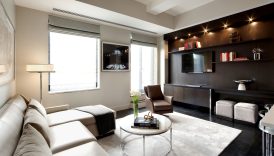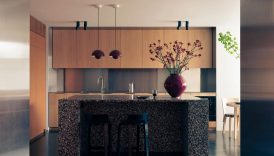Bringing Life to Your Home: Inspirational Interior Design Concepts

Importance of Interior Design
Interior design goes far beyond mere aesthetics; it is a crucial aspect that shapes how we experience our surrounding spaces. A thoughtfully designed interior can enhance functionality, promote well-being, and reflect personal style. From cozy residential homes to dynamic commercial spaces, the impacts of interior design are profound. For instance, think about how entering a warmly lit room with chosen decor can immediately evoke feelings of comfort and relaxation. This transformative power makes interior design essential in everyday life.
- Bringing Life to Your Home: Inspirational Interior Design Concepts
- Importance of Interior Design
- How Design Impacts Mood
- Choosing the Right Color Palette
- Understanding Color Psychology
- Creating a Harmonious Space
- Incorporating Natural Elements
- Benefits of Biophilic Design
- Ways to Bring Nature Indoors
- Furniture Layout and Placement
- Maximizing Space Efficiency
- Creating Functional Areas
- Lighting Techniques for Ambiance
- Importance of Proper Lighting
- Types of Lighting Fixtures
- Personalizing Your Space
- Showcasing Personal Style
- Adding Meaningful Decor
- Embracing Minimalism
- Simplifying Your Home
- Decluttering Tips
- Statement Pieces and Focal Points
- Choosing Bold Centerpieces
- Creating Visual Interest
- Mixing Textures and Patterns
- Adding Depth to Your Design
- Tips for Pattern Coordination
- Bringing Life with Indoor Plants
- Benefits of Houseplants
- Easy-to-Care-For Plant Options
How Design Impacts Mood
The design elements of a space can significantly influence mood and emotions, affecting everything from productivity to relaxation. Here’s how:
- Color Schemes: Calming blues and greens can spark tranquility, while vibrant reds can boost energy levels.
- Layout: Open spaces promote collaboration, while cozy nooks encourage solitude.
- Textures: Soft fabrics can offer comfort, while sleek metals might induce a modern, energetic feel.
For instance, a well-designed home office with adequate lighting and calming colors can lead to increased focus and productivity, illustrating the power of design in cultivating the right atmosphere.
Choosing the Right Color Palette
Understanding Color Psychology
Once the importance of interior design and mood has been established, one cannot overlook the powerful role that color plays in setting the tone of a space. Color psychology suggests that different hues evoke distinct emotions and feelings. For example:
- Blue: Often associated with calmness and stability, it’s a fantastic choice for bedrooms.
- Yellow: This vibrant shade can inspire happiness and creativity, making it ideal for kitchens and playrooms.
- Green: Represents nature and balance, promoting relaxation in living spaces.
Considering these associations can help paint a desired mood for any room, affecting how you or your guests feel while inside the space.
Creating a Harmonious Space
Choosing a color palette doesn’t just involve individual colors; it’s about creating harmony among them. A well-coordinated palette can visually unify a room. Here are some tips:
- Use the 60-30-10 Rule:
- 60% of the room should be a dominant color,
- 30% a secondary color,
- 10% an accent color.
- Choose Complementary Colors: Pair colors that are opposite each other on the color wheel for a visually striking effect.
For instance, a living room with soft beige walls (dominant), teal furniture (secondary), and orange throw pillows (accent) can create an inviting and lively atmosphere. Balancing colors harmoniously ensures that each space reflects a cohesive aesthetic while also supporting the intended mood.
Incorporating Natural Elements
Benefits of Biophilic Design
Following the discussion on color palettes, adding natural elements to your interior design can elevate the atmosphere even further. This approach, known as biophilic design, taps into the innate human connection with nature. Integrating these elements has numerous benefits:
- Improved Mood: Exposure to natural elements can significantly reduce stress and enhance feelings of well-being.
- Increased Productivity: Research suggests that environments that include nature can boost creativity and focus.
- Enhanced Air Quality: Plants can help purify the air, making indoor spaces healthier.
A personal experience illustrates this beautifully: after adding a few potted plants and natural wood finishes to my workspace, I noticed a marked improvement in my energy levels and concentration.
Ways to Bring Nature Indoors
So, how do we achieve this green design in our own homes? Here are some easy ways to incorporate nature indoors:
- Indoor Plants: Choose easy-to-care-for plants, like snake plants or pothos, to add greenery effortlessly.
- Natural Materials: Use furniture and decor made from wood, stone, or bamboo for an organic look.
- Natural Light: Maximize window space and use sheer curtains to allow sunlight to flood the room.
By thoughtfully integrating these natural elements, anyone can create a tranquil retreat that reconnects them with the outdoors.
Furniture Layout and Placement
Maximizing Space Efficiency
As we continue to explore ways to enhance our interiors, the layout and placement of furniture become crucial. Effective furniture arrangement not only optimizes space but also fosters a more inviting environment. For example, placing larger furniture pieces along walls creates an open central living area, making the room feel more spacious. Some tips to maximize space efficiency include:
- Scale and Proportion: Choose furniture that complements the size of the room; oversized items in small spaces can feel suffocating.
- Create Pathways: Ensure there’s ample room for movement; aim for clear pathways of about 24 inches between major pieces.
- Multi-functional Furniture: Consider pieces with built-in storage or convertible options, like a coffee table that doubles as a storage unit.
Creating Functional Areas
Beyond maximizing space, it’s vital to create functional areas that serve distinct purposes within your home. Think about how you live and what activities you enjoy. Here’s how to achieve that:
- Define Zones: Use rugs or furniture arrangements to delineate different areas within a room. For instance, a sofa can create a cozy reading nook.
- Adapt to Activities: Arrange seating around a focal point, like a television or fireplace, to enhance family interactions.
In my own home, creating a dedicated workspace allowed me to separate my professional life from my personal space, leading to increased productivity and clarity. Thoughtful furniture layout can transform any room into a harmonious blend of functionality and style.
Lighting Techniques for Ambiance
Importance of Proper Lighting
Building upon the furniture layout and placement, one cannot underestimate the significance of proper lighting in interior design. Lighting sets the mood for a space, influencing how it feels and functions. A well-lit room can enhance décor and create a welcoming atmosphere. Here are a few reasons why lighting matters:
- Mood Enhancement: Soft, warm lighting invites relaxation, while bright lighting can energize a workspace.
- Visual Appeal: Good lighting highlights design features and artwork, making them focal points in the room.
- Safety and Functionality: Well-lit pathways and workspaces ensure safety and ease of use in daily activities.
For example, after switching to dimmable LED bulbs in my dining area, the flexibility to adjust light levels transformed our family dinners from ordinary to special occasions.
Types of Lighting Fixtures
Understanding the various types of lighting fixtures is essential for creating an effective lighting plan in any home. Here are the primary types you should consider:
- Ambient Lighting: General illumination; ceiling fixtures, chandeliers, or recessed lighting provide overall brightness.
- Task Lighting: Focused lighting for specific activities; desk lamps or under-cabinet lights in the kitchen are perfect examples.
- Accent Lighting: Highlights particular features like artwork or architectural details; wall sconces and track lighting work well here.
By thoughtfully combining these types of lighting, homeowners can create an inviting space with the perfect ambiance for any occasion.
Personalizing Your Space
Showcasing Personal Style
Continuing from our discussion on lighting, personalizing your space is an exciting way to express who you are and create an environment that feels distinctly yours. Showcasing personal style can turn any room from generic to extraordinary. Here’s how to do that:
- Incorporate Favorite Colors: Use colors that resonate with your personality, perhaps through wall paint or accent pieces.
- Unique Furniture Finds: Consider thrift stores or antique shops for one-of-a-kind pieces that tell a story.
- Mixing Styles: Blend traditional and modern furnishings for a look that’s uniquely you.
For instance, my living room features a vintage armchair next to sleek contemporary furniture, creating a conversational and inviting atmosphere that reflects my eclectic taste.
Adding Meaningful Decor
In addition to showcasing your style, adding meaningful décor can infuse your space with memories and sentiments. Here are some ideas:
- Artwork: Display pieces that resonate with you, whether they’re purchased or homemade.
- Travel Mementos: Incorporate souvenirs from memorable trips, such as framed photos or trinkets, to evoke positive memories.
- Sentimental Items: Family heirlooms or gifts from loved ones can serve as beautiful reminders of cherished connections.
By thoughtfully integrating elements that matter to you, your home becomes a personalized sanctuary filled with inspiration and warmth.
Embracing Minimalism
Simplifying Your Home
Building on the idea of personalizing your space, embracing minimalism offers a refreshing approach for those seeking simplicity and tranquility in their homes. A minimalist lifestyle focuses on quality over quantity, allowing you to prioritize what truly matters. This doesn’t mean stripping your space of personality; rather, it involves curating your belongings thoughtfully. Consider these strategies:
- Choose Functional Decor: Opt for decorative items that serve a purpose, such as stylish storage solutions or multi-functional furniture.
- Limit Clutter: Keep surfaces clear to create a sense of openness and calm. This not only enhances aesthetics but also uplifts the mood.
- Simplified Color Schemes: Stick to neutral tones or a limited color palette for a serene backdrop that feels cohesive and spacious.
For example, since adopting a minimalist approach in my home office, I’ve found it much easier to focus without distractions.
Decluttering Tips
To fully embrace minimalism, decluttering becomes essential. Here are effective tips to help streamline your belongings:
- The One-Year Rule: If you haven’t used an item in the past year, consider letting it go.
- Create Donation Bins: Designate boxes for items to donate, allowing you to separate what you no longer need easily.
- Organize by Category: Tackle a specific category (clothes, books, etc.) at a time to make the process less overwhelming.
Utilizing these decluttering techniques can transform your environment into a serene retreat, inviting clarity and peace into your everyday life.
Statement Pieces and Focal Points
Choosing Bold Centerpieces
As we move from the simplicity of minimalism, introducing statement pieces can effectively elevate the aesthetic of any room. These bold centerpieces can captivate the eye and serve as powerful focal points. When selecting a statement piece, consider options like:
- Unique Art: A large canvas or sculpture that reflects your style can energize a space.
- Colorful Furniture: Opt for a vibrant sofa or armchair that draws attention and creates a striking contrast against neutral tones.
- Bold Light Fixtures: Chandelier or pendant lights can serve as functional art, enhancing both the decor and ambiance.
In my living room, a striking, oversized painting instantly transforms the mood, making guests feel welcomed and intrigued.
Creating Visual Interest
After you’ve identified your statement pieces, the next step is creating visual interest throughout the space. Here are ways to achieve that:
- Layering Textures: Mix materials, such as wood, glass, and fabric, to add depth and richness.
- Varying Heights: Arrange decor at different heights, using tall vases or short books stacked creatively.
- Gallery Walls: Curate a collection of artwork or photographs for an engaging and personal display.
By strategically placing and arranging bold centerpieces and diverse elements, your home can become a vibrant tapestry that invites exploration and appreciation.
Mixing Textures and Patterns
Adding Depth to Your Design
Following our exploration of statement pieces, mixing textures and patterns can further enhance the visual appeal of your space. When done thoughtfully, this practice adds depth and complexity, making interiors feel rich and inviting. Different textures can evoke various sensations; for example, combining soft fabrics with hard surfaces creates a harmonious balance that engages the senses. Consider incorporating:
- Contrasting Materials: Pair smooth fabrics like silk with textured elements like a chunky knit throw or a woven rug.
- Layering Textures: Incorporate pillows, throws, and a variety of finishes to create an inviting, lived-in feel.
In my bedroom, mixing a velvet bedspread with a woven rattan chair induces a cozy yet sophisticated atmosphere that beckons relaxation.
Tips for Pattern Coordination
To achieve a cohesive look while mixing patterns, here are some useful tips:
- Choose a Color Palette: Stick to a limited color scheme to ensure that the patterns complement instead of clash.
- Vary Scale: Mix large-scale patterns with smaller designs for balance—think bold stripes paired with delicate florals.
- Use the Rule of Three: Incorporate three different patterns to avoid overwhelming the space while maintaining visual interest.
By applying these strategies, you can create a beautifully layered environment that radiates character and charm.
Bringing Life with Indoor Plants
Benefits of Houseplants
Continuing from the rich textures and patterns we’ve discussed, another fantastic way to enhance your interior is by bringing life through indoor plants. These natural additions can transform any room into a vibrant oasis. The benefits of houseplants are numerous:
- Air Quality Improvement: Plants like spider plants and peace lilies can filter toxins from the air, promoting a healthier environment.
- Mood Enhancement: Studies show that greenery can reduce stress and boost happiness levels. Just looking at lush plants can have a calming effect.
- Aesthetic Appeal: They add color and texture, making your space feel more inviting and lively.
For example, my living room instantly brightened up when I placed a tall fiddle leaf fig in the corner, effortlessly adding both height and character to the room.
Easy-to-Care-For Plant Options
If you’re new to gardening or have a busy schedule, opting for low-maintenance plants is a great way to start. Here are a few easy-to-care-for options:
- Snake Plant: Thrives on neglect and can survive in low light.
- Pothos: Fast-growing and adaptable, it only requires occasional watering.
- ZZ Plant: Perfect for low-light environments and drought-tolerant, making it ideal for beginners.
By incorporating these houseplants into your decor, you not only elevate your design but also create a nurturing environment that feels alive and rejuvenating.





